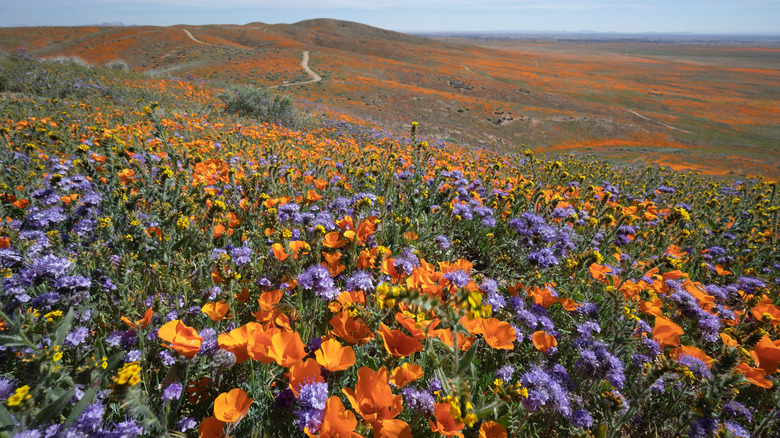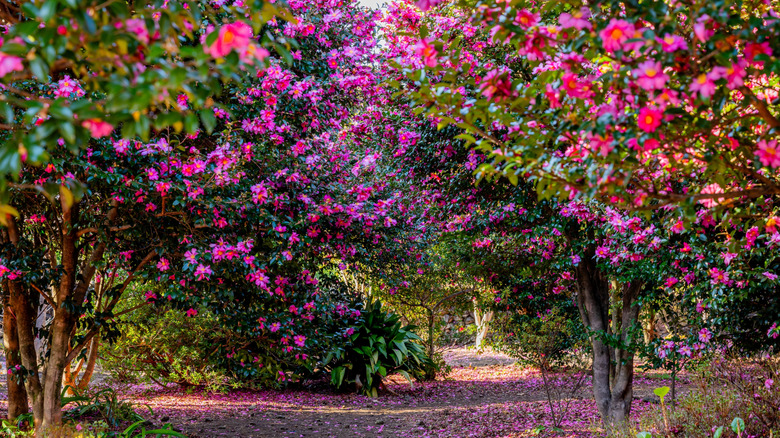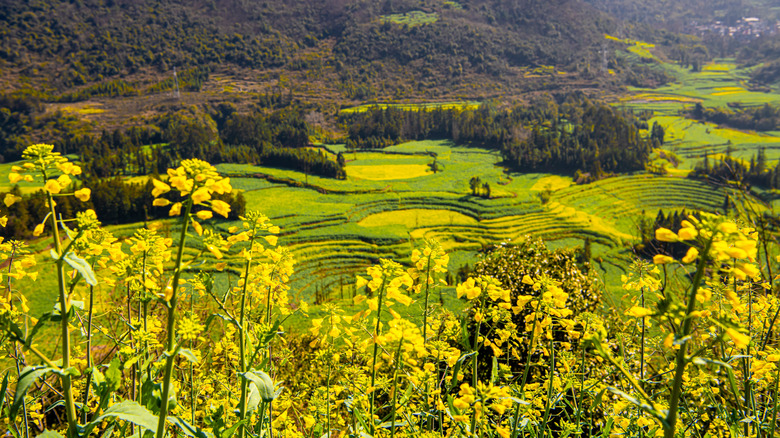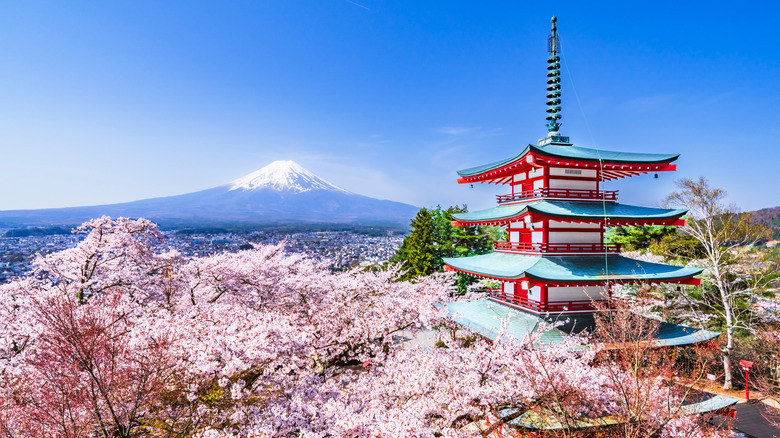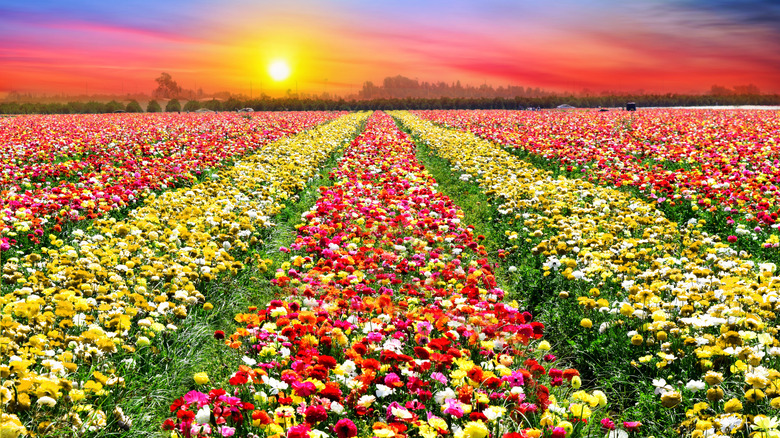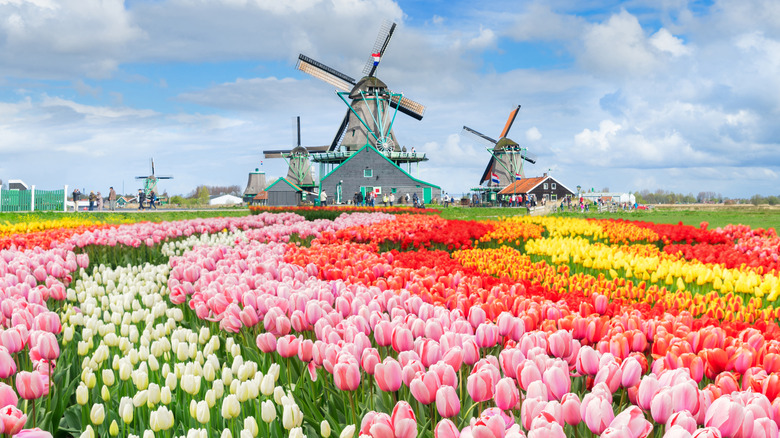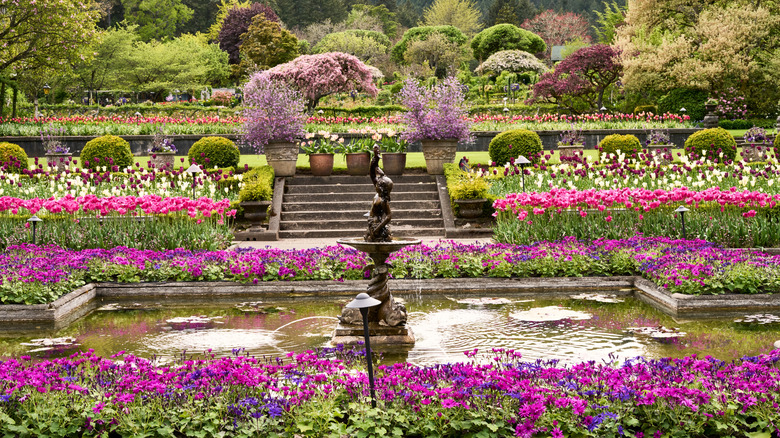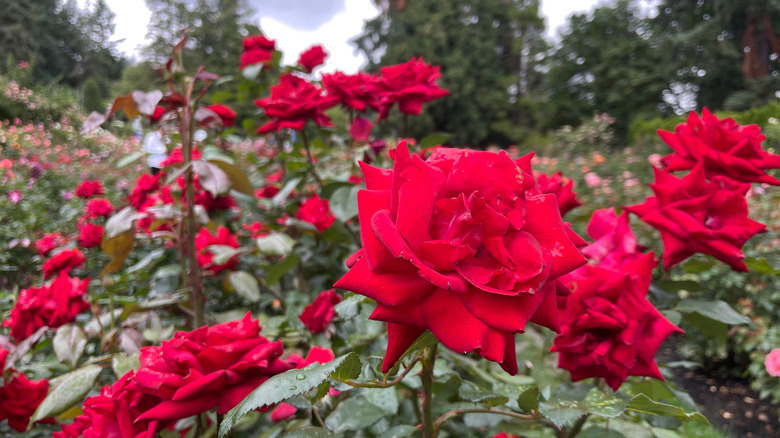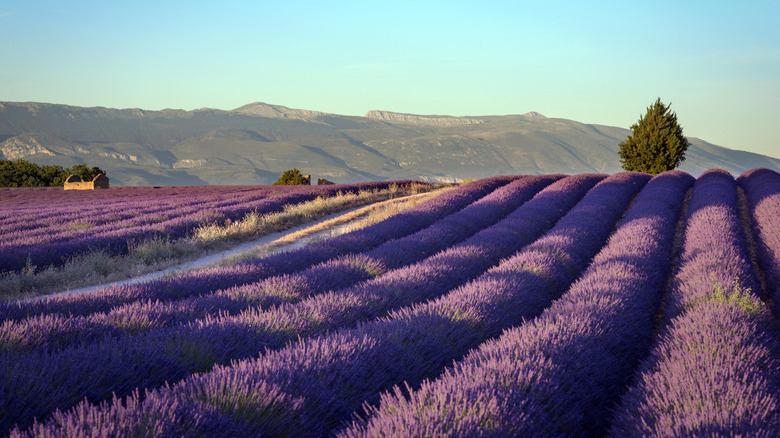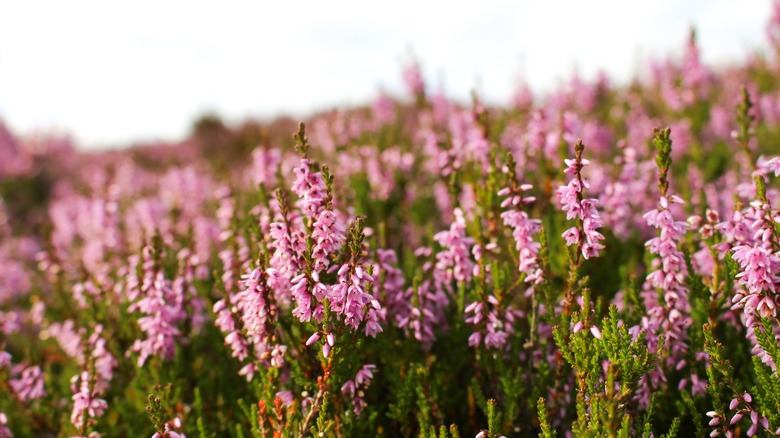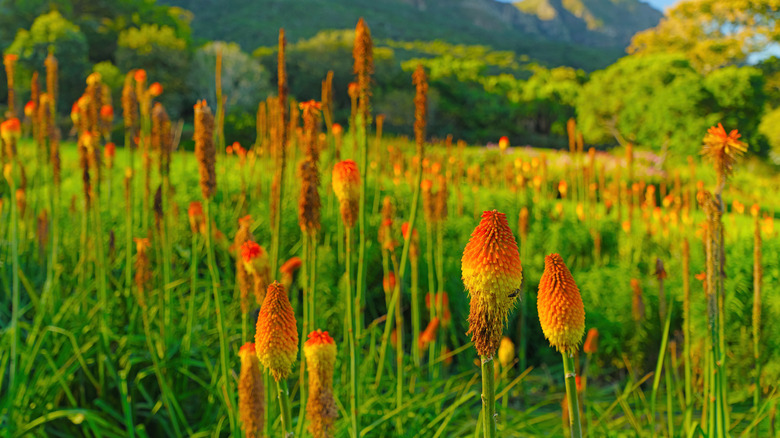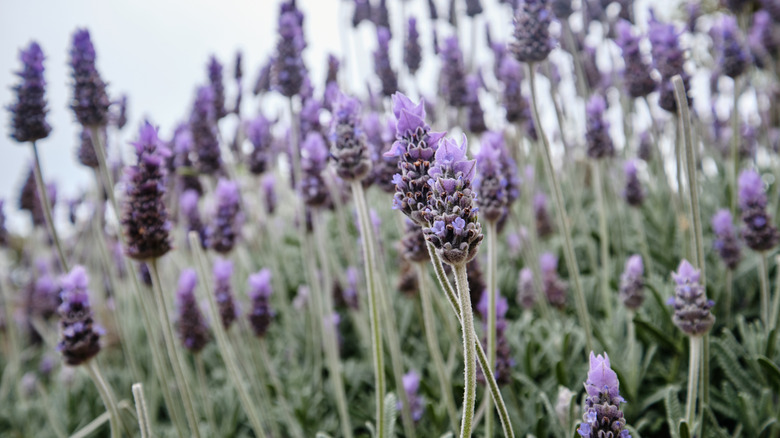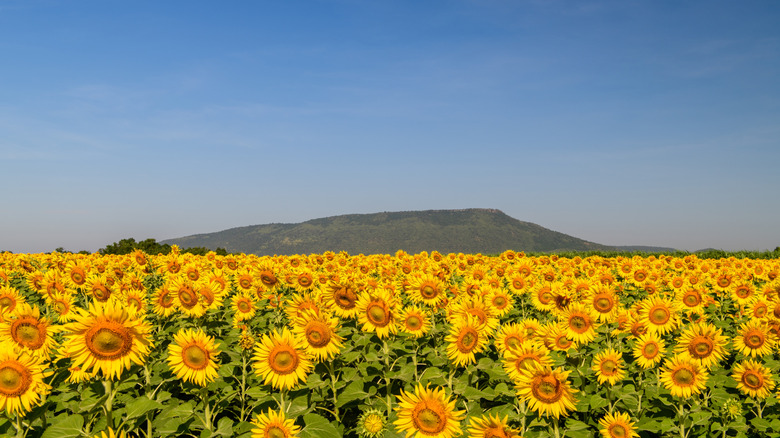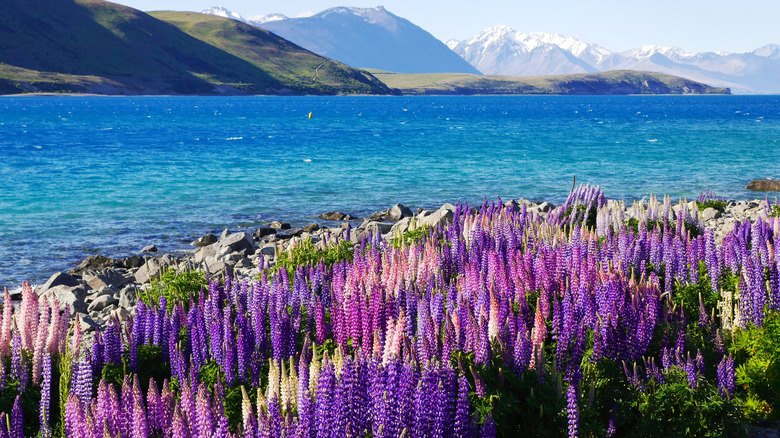13 Mesmerizing Places To See Flowers In Bloom Around The World (No Matter The Season)
There's just something about blossoming flowers that inspires a gorgeous feeling of peaceful joy. These vibrant blossoms are beautiful reminders of the spectacular power of nature. Colorful flowers make such an impression that there are certain destinations around the world that we immediately associate with their famous flowers, like cherry blossoms in Japan, tulips of all colors in the Netherlands, and lavender in Provence. Huge crowds of people plan trips to these destinations during peak season just for the chance to see these flowers in bloom.
Spring blooms can be short-lived, and their transient nature adds to their beauty. Fortunately, you can always find flowers in bloom somewhere in the world. After all, not only does spring happen in different months between the Northern and Southern Hemispheres, but some flowers only bloom in the summer while others thrive in the cooler weather that winter brings. The list below details the places around the world where you can see a variety of blossoms — from large sunflowers to purple lupins — during each month of the year.
January: Camellias in South Korea
Camellias are native to Southern Japan and primarily found in Asia, though the flowers have managed to blossom worldwide. The flower has a particular significance in South Korea, symbolizing longevity and perseverance because the camellias often bloom in the winter. While you wouldn't normally expect vibrant pink flowers in the middle of winter, January is the ultimate time to see camellias thrive in South Korea. The splash of color can really brighten your cold day and is a stunning contrast against the wintry landscape.
One of the best places to see camellias is Jeju, South Korea's ultimate island destination, where there is no shortage of spots to spy vibrant red and pink blossoms in winter. First, there's Camellia Hill, where visitors can take a short trail to view 6,000 camellia trees, including 500 different species. If you prefer your flower viewing with a side of coffee and dessert, head to Manor Blanc, a garden cafe in Seogwipo City full of camellias and photo ops. Aside from Jeju, other islands such as Odongdo and Jisimdo also boast camellia forests that are well worth visiting.
February: Rapeseed flowers in China
Also known as canola, rapeseed is the plant used to produce canola oil. Luckily for us, it also produces beautiful bright yellow flowers. As China is one of the largest producers of canola products in the world, there are a number of areas where you can see these yellow beauties blooming in what resemble fields of endless gold. The agricultural county of Luoping in China has been growing rapeseed flowers for decades, and the fields turn into a beautiful sea of yellow when the flowers are in bloom.
As opposed to seeing the flowers close up, the fields of rapeseed in Luoping are best admired from a distance, so hike to the top of Jinji Peak to get a panoramic view of the hills covered in yellow flowers. If a steep climb isn't your cup of tea, there are also a number of viewing platforms around the area, giving visitors a panoramic viewpoint without the sweat, chief among them being Luosi Field. Luosi means "screw" in Chinese, and the field's name comes from its circular structure, thought to resemble screws. You can be the judge, but the vibrant beauty of the yellow flowers is undeniable.
March: Cherry blossom in Japan
Japan has long been a very popular destination, and explorers are particularly fond of visiting the country during cherry blossom season in the spring. Cherry blossom season in Japan takes place throughout March and April, with different peak times in different parts of the country. In iconic destinations like Tokyo and Kyoto, the cherry blossoms start flowering at the end of March, but other areas see blossoms earlier. If you visit Japan in early March, head to Shizuoka to catch the sakura blooms in late February to mid-March.
Different cherry blossom species bloom at different times, and you can find sakura in Tokyo even earlier. That means that whether you come to Japan in early or late March, you should still find some cherry trees in bloom if you know where to look. Kawazu cherry trees are known for blooming earlier than other varieties, and you can find kawazu cherry trees blooming in early March in various Tokyo parks, including Shinjuku Gyoen National Garden and Yoyogi Park. It doesn't get much more romantic than a springtime cherry blossom adventure in Japan.
April: Ranunculus in Carlsbad, California
The Flower Fields are one of the many claims-to-fame of the underrated beach town of Carlsbad, California. The Flower Fields has 55 acres of Giant Tecolote Ranunculus flowers that bloom from early March through early May, with April being the peak season to visit. It all started with a horticulturist named Luther Gage, who settled in the area in the early 1920s and started growing ranunculus flowers, a plant native to Asia Minor. Fast forward to the modern age, and you have one of California's most magnificent explosions of floral magic.
The Flower Fields is also an early example of agrotourism, and the money raised by visitors helped to keep the flower fields running. The move was a great success. Today, more than 300,000 visitors make their way to the Flower Fields each spring, and you don't need to be an amateur botanist to understand why. Alternating colors of ranunculus flowers are planted in each row, creating a vibrant display of different hues that stretch as far as the eyes can see. There are pathways between each row of flowers, allowing visitors to get close to the flowers for the perfect photo. The Flower Fields is a family-friendly attraction, and in addition to the flowers themselves, kids can enjoy the maze, tractor wagon ride, and butterfly encounters.
April: Tulips in the Netherlands
April gets two entries here, as Tulips are such an iconic symbol of the Netherlands that we'd be doing the entire concept a disservice if we failed to include them. There are plenty of places to admire the colorful bulbs around the country, and one of the most famous (and best) places to see tulips here is Keukenhof Gardens, which is usually open from the end of March until the beginning of May. Located near Liss, the Keukenhof Gardens (popularly known as the Garden of Europe) is easily reachable via public transport from Amsterdam, and the journey takes only around 30 minutes.
For those who want to venture into the middle of the field and take vibrant photos among the blooming tulips, a visit to a tulip farm should be the move instead. The aptly named Tulip Experience in Noordwijkerhout (40 minutes south of Amsterdam) is a fabulous spot, growing up to 4 million tulips annually. Once you're done taking photos of the flowers, you can also find all kinds of drinks or buy products made with tulips. Further afield, Kop van Noord-Holland in North Holland is home to the largest tulip area in the Netherlands.
May: Butchart Gardens in Victoria, Canada
Butchart Gardens in Victoria, British Columbia, was established when Jennie Butchart started planting her garden in 1912 in a former limestone quarry, eventually creating what today is known as the Sunken Garden. The world-famous garden welcomes more than a million visitors annually and is worth visiting at any time of year, as there are hundreds of thousands of plants here. Naturally, spring is the most colorful season, with over 300,000 flowers in the gardens creating a spectacular blanket of color. However, May is another excellent option if you want to see plenty of blossoming flowers, and there is also a lower chance of rain compared to March or April.
In May, you'll find rhododendrons (there are 2,000 shrubs throughout the garden), daffodils, and even the rare Himalayan blue poppy in bloom. Widely regarded as a difficult flower to grow, the Himalayan blue poppy typically blooms sometime in mid-May to mid-June, depending on the weather. Even if you aren't lucky enough to catch a glimpse of this stunning flower, you should have no problem enjoying the remaining tulips and cherry blossoms that are still in bloom when visiting this fabulous garden.
June: Roses in Portland, Oregon
Portland, Oregon, is home to the International Rose Test Garden, the oldest continuously operating rose garden in the country (it was established in 1917). The rose garden has over 10,000 roses with more than 600 different varieties and is a must-visit when the beautiful roses are in bloom. Better yet, admission to the garden is free. The roses bloom between May and September, with the peak bloom occurring sometime in early to mid-June.
The International Rose Test Garden isn't the only rosy reason to visit Portland in June. After all, Portland is called the City of Roses for good reason. You can find roses at the Peninsula Park Rose Garden, Ladd Circle Park, the historic Pittock Mansion, or simply by walking around the different neighborhoods of the city. The Portland Rose Festival takes place from the end of May through June, and the city-wide festival holds multiple events, including a Grand Floral Parade at the beginning of June and the annual Spring Rose Show at Lloyd Center.
July: Lavender in Provence, France
Provence is one of the most well-known regions of France and is typically associated with wine, artists, and gastronomy, yet the southeastern area is also closely associated with fragrant lavender. The lavender fields in Provence are mostly located north of Marseille and Aix-en-Provence, along the Luberon and Verdon plateaus. Typically, the lavender starts blooming at the end of June and is harvested around the end of July or early August. July is the best month to visit the lavender fields, as the flowers are still in peak bloom, and the harvesting hasn't yet begun.
There are numerous lavender fields to visit in the area, and travelers who don't have a rental car can book guided day trips from Marseille or Aix-en-Provence. Most of the lavender fields — such as Terraroma and Lavande Angelvin — have stores where you can shop for all kinds of lavender-infused products. Alternatively, take a walk along the Lavender Path in Sault, a 3-mile trail filled with spectacular views and the ever-present scent of Provence's most famous flower.
August: Heather in Scotland
While Scotland is mainly known as a whisky destination with a rich cultural heritage, the country also has a diverse system with plenty of flora. One of the most famous flowers of Scotland is the heather, a flower considered one of the symbols of Scotland that has found itself mentioned in many legends and myths. It is said that the white heather brings good fortune to new brides, so keep that in mind next time someone you know is walking down the aisle.
The most common type of heather in Scotland is the Ling heather, which has pink-purple flowers and grows abundantly in the moors and on the storied hills of the country. A view of the Scottish Highlands blanketed in a large swath of pink and purple is one of the most romantic sights in the United Kingdom. Heather blooms twice a year in Scotland, with the peak bloom in August. One of the best places to see heather in bloom is at Cairngorms National Park, but the purple flowers can also be found on the famously scenic Isle of Skye.
September: Cape Floral Region in South Africa
South Africa is packed with unique landscapes and biodiversity, from the iconic Table Mountain to its own wine country, the Cape Winelands. A lesser-known but equally beautiful spot is the Cape Floral Region, which encompasses an area in the southern tip of South Africa and is a must-visit for anyone with even a passing interest in flowers (and natural beauty). Not only are the wildflowers beautiful here, but 30% of the plants found in this region do not exist anywhere else in the world.
The most accessible part of this floristic region is Kirstenbosch National Botanical Garden, which also happens to be the first botanical garden on the planet that is solely dedicated to indigenous flora. In September, you can admire Namaqualand daisies and vygies in all manner of colors. For the more adventurous, the trails in Table Mountain, Cape Point, or the Postberg Nature Reserve promise hikes full of wildflowers you may not be familiar with.
October: Wildflowers at Grampians National Park, Australia
As Australia is located in the southern hemisphere, spring takes place from September to November, making October the prime time for spring wildflowers. Head to Grampians National Park in Victoria for the best wildflower viewing. In fact, Australia's indigenous people call the period between September and November "petyan," which means the season of wildflowers. The park is 656 square miles large and is home to more than 1,000 species of wildflowers, including more than a dozen that are only found in the area.
Some of the flowers in the Grampians include orchids, pea flowers, heaths, and bluebells. Keep in mind that this national park is home to nine different ecosystems, so you can spot unique flora in different areas of the park. While you can see wildflowers on hiking trails, it would take some time to explore all that the nature reserve has to offer. Alternatively, you can also easily see most of the flowers (and other plants) that grow in the area at Halls Gap Botanic Garden.
November: Sunflowers in Lopburi, Thailand
Lopburi province in Thailand is located around a two-hour drive from Bangkok and is known for its rich history and collection of Khmer ruins. The area also attracts many visitors in November thanks to an unexpected winter attraction: sunflowers. Yes, while we typically associate sunflowers with summer, in Thailand, they bloom in the winter. Thai farmers start planting sunflowers in September as the cooler weather is better for their growth and flowering.
The sunflowers are actually grown by farmers for harvesting sunflower oil and seeds, but that doesn't mean we can't enjoy the iconic beauty of the flowers. After all, fields upon fields of sunflowers make for quite a spectacle. Thanks to the popularity of these sunflowers, there are now plenty of sunflower fields you can visit in the area for a small fee of around 20 baht (less than US $1). One of the more popular fields is Rai Wichan Sunflower Field, which offers a sightseeing tram so visitors don't have to walk the large field on foot and has also set up plenty of spots for the best photo ops.
December: Lupins at Lake Tekapo, New Zealand
December marks the beginning of summer in the Southern Hemisphere. Lake Tekapo on New Zealand's South Island is a picturesque lake surrounded by mountains, and it's particularly stunning at the end of the calendar year. During this time, lupins are in full bloom, covering the landscape around the lake with tall flowers in shades of pink, purple, and yellow. The colors are even more vibrant when juxtaposed with the snow-capped mountains in the backdrop.
Lupins are actually considered pests in New Zealand and are not native to the area, but the flowers sure are beautiful. A local farmer introduced them to the Mackenzie Country region in the 1940s, and the plant soon took hold across the country. Lake Tekapo is certainly the most famous and picturesque spot for lupin spotting, but there are other places in New Zealand where you can catch the flowers. Other areas include the Mackenzie Basin and Lake Pukaki, which are located near Lake Tekapo, as well as Ahuriri River in the Otago Region. Keep in mind that despite being an invasive species, you still should not pick the wild lupins you find, as they're protected in certain areas.
